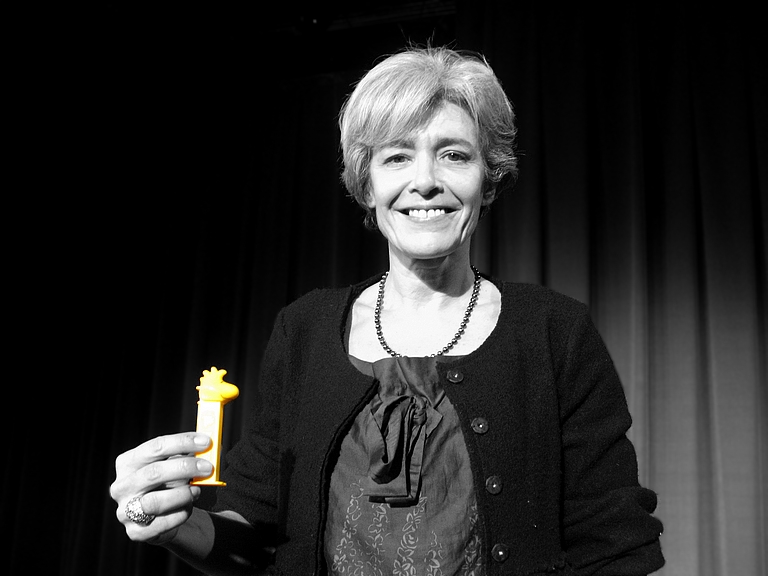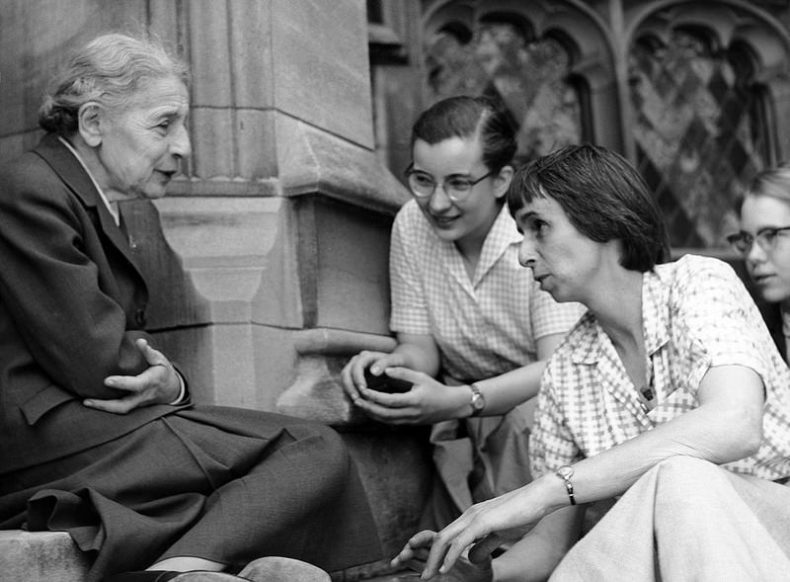 Apparently we’re feminine/ist this week, or so far Emma and I are. I want to argue about the Finkbeiner Test. The test began with a heroic vow: I would write a profile of a woman scientist without the clichés that litter these profiles. The test took off when Christie wrote a post about my post for Double X Science, making a solid argument in which she listed the cliches as bullet points. And it became nationally famous when the New York Times began the obituary of a woman rocket scientist with “She made a mean beef Stroganoff.” (The Times had to change that sentence and you may picture me smiling evilly as I type this.) In general, the Finkbeiner Test* comes down to this: if you’re not writing it about a man scientist, then why would you write it about a woman scientist?
Apparently we’re feminine/ist this week, or so far Emma and I are. I want to argue about the Finkbeiner Test. The test began with a heroic vow: I would write a profile of a woman scientist without the clichés that litter these profiles. The test took off when Christie wrote a post about my post for Double X Science, making a solid argument in which she listed the cliches as bullet points. And it became nationally famous when the New York Times began the obituary of a woman rocket scientist with “She made a mean beef Stroganoff.” (The Times had to change that sentence and you may picture me smiling evilly as I type this.) In general, the Finkbeiner Test* comes down to this: if you’re not writing it about a man scientist, then why would you write it about a woman scientist?
Recent specific examples:
- Last week, I heard a woman scientist being introduced as the first woman to win the Crafoord Prize.
- Also last week I read a well-researched, well-written profile in a science magazine of another woman scientist whose science is careful but her results are unexpected and therefore controversial; also she has children, her ex-husband’s opinion of her work is low, she finds the controversy difficult to handle, and in fact, her field’s aggressiveness has cost her an NSF grant.**
- And the week before last, I finished writing a profile of yet another woman scientist: she worked much of her career without a university job, finally got one with tenure at age 59.
Would you write any of these things about a man scientist? any at all? You would not. He’d never be the first man to win an established prize. His children and his ex-wife’s opinions would be seen as patently irrelevant. His controversial work and his ability to withstand his field’s aggressiveness would make him not fragile, but an iconoclastic hero. And by age 59 he’d be thinking retirement. You write about women scientists saying these same things, even though all are meant as compliments, and wouldn’t you suspect these women of being, well, you know, sort of affirmative-actiony, kind of weepy, a little second-tier, maybe not quite top-drawer? You would.
The Finkbeiner Test caught a certain amount of flack***, all of it rational and politely-expressed and usually posed as questions. I am here to answer them. Ever since Christie got us famous using bullet points, I’m all enthusiastic about bullet points.
Ever since Christie got us famous using bullet points, I’m all enthusiastic about bullet points.
- Question: Shouldn’t the personal details – the childcare arrangements, the husband’s job – also be included in profiles of male scientists, that is, be part of humanizing a scientist’s image?
- Answer: Nope, even though humanizing scientists is one of science writers’ great desiderata. Plenty of humans deal with childcare and spousal jobs; what makes scientists interesting is their research. So, if you want to humanize them, ask them how they got interested in their fields, how they stuck with their interests, how one interest led to the next, whether they worry about being wrong. Ask what parts of their lives or characters led them to work on something so hard. Because childcare and spousal jobs are not interesting.
- Question: Shouldn’t the gender inequities in the woman scientist’s field be mentioned? shouldn’t her being first to win a prize be an honor? shouldn’t we know that her women students find her a role model? Aren’t inequities, prizes, and role-modelling all part of the long jump that women scientists have to nail?
- Answer: same answer as above. Sure, fine, of course, but the questions are all irrelevant. They’re not about the science that interests the scientist and that makes her interesting. They’re about prejudice in the fields of science, about blinkered prize-giving committees, about expectations in the students.
But now that I’ve laid down the law, I run into a problem. I wrote a profile of a woman scientist who began her scientific career with an excellent education and a small, specific interest that eventually became evidence in the solution of a huge problem. She’s also of the age that made up the first sustained trickle of women into science. So she did what most of these first-line women scientists did. She and her scientist-husband agreed that he’d get a job first and then she’d try to get a job in the same place. She did this for place after place, job after job, year after years, even though the places never gave her positions or money and provided only the conduits for the grants that funded her research. She raised three children. She followed her husband’s advice: just publish enough good science in enough good journals and you’ll be ok. And she was; at age 59 she finally got a tenured position; at age 73, in 2004, she was the first and only woman to receive a scientific medal that’s been given out since 1989. At 86, she’s still working; she published several papers this year. She has what looks like a normal scientific career, only redshifted by 20 years.
You’ll have to agree that at the least she is remarkably persistent and that her persistence is relevant, even central, to her career. I forgot to add, her women students have ended up with excellent jobs and are grateful to her for being such a good role model. I thought I might have to write a profile that would consciously fail the Finkbeiner Test, then change my name and move to New Zealand.
But then I thought I’d better check with her. I explained the test to her and asked if she thought a profile could represent her fairly and still pass the test. She said, and I quote her exactly: “I’m all with you and so relieved. I am a paleoecologist who happens to be female. I am so tired of talking about ‘what was it like to be a woman etc etc.’ The work I did is unrelated to my sex. So I am happy to be written about for what I do and not who I am.”
Well by God then, let’s do it.
_____
* People compare the Finkbeiner Test to the Bechdel Test. The comparison is fair and I’m charmed by it. But when I wrote the original post, I’d never heard of the Bechdel Test. Just so you know, I wasn’t copying.
**I know. This makes no sense whatever. But here are the sentences: “The battles have taken a toll on her funding, too; her National Science Foundation grant runs out in the fall. ‘I worry constantly about keeping the lab going,’ she says.”
***Really, just google Finkbeiner Test. Lots of links, just pick one, they’re all good. This is the Wikipedia article.
__________
Photos: astronaut Claudie Haigneré – PhOtOnQuAnTiQuE; physicist Lise Meitner (left) talking to students and faculty at Bryn Mawr College including Sue Jones Swisher (rear, center of photo), Professor Rosalie Hoyt (front right), and Danna Pearson McDonough (partially visible on right) – NRCgov; both via Flickr; names in the Meitner picture from the American Institute of Physics, via my ex-step-daughter-in-law’s mother, Sue Broughton.
Is it too much to hope for that the Finkbeiner test could spawn off a corollary proposition? One that adds awful, cloying verbiage to profiles of *male* scientists?
“Albert Einstein looked out over the Princeton campus as he groomed the crest of his cockatoo, Pookie…”